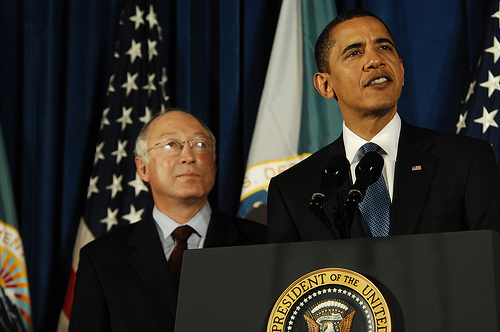 Image: Positioning GreenCross-posted from Positioning Green.
Image: Positioning GreenCross-posted from Positioning Green.
Billionaire conservative financier David Koch doesn’t know it, but the cutting-edge energy-saving technologies included in a brand new $211 million research lab that bears his name were partly funded through a government program to reduce global warming pollution. It happens to be the very same program under a blistering attack by one of Koch’s biggest political beneficiaries, the group Americans for Prosperity (AFP).
Here’s the story, which is cross-posted at Climate Progress, but has not otherwise been publicly reported:
The David H. Koch Institute, dedicated earlier this month at the Massachusetts Institute of Technology, will use almost a third less energy than comparable facilities. Everything in the building is designed to maximize efficiency, from lighting and climate controls to the laboratory systems — even the floorplan.
Money for all those extras came through MIT’s $14 million campus-wide partnership with their utility, NSTAR. In just 36 months, they plan to cut the university’s energy use 15 percent — enough to power 4,500 Massachusetts homes for a year. The total lifetime payback is expected to exceed $50 million.
But NSTAR didn’t just decide to do this on its own. By law, Massachusetts utilities are required to pay for efficiency upgrades whenever the energy savings cost less than building the equivalent amount of new generating capacity. Funding comes from ratepayers, same as it would for a new power plant.
And as it turns out, almost a fifth of that money last year came from the Regional Greenhouse Gas Initiative (RGGI, or “Reggie”), the pioneering agreement by 10 Northeast states that limits the amount of carbon dioxide utilities can put in the air and collects a small fee — set by auction — for every ton of they emit.
Koch would not be alone in missing the RGGI connection. In fact, many top supporters of the increasingly embattled program didn’t know about it either. And that is precisely why RGGI is in trouble today.
Thousands of businesses, families, and local communities are reaping RGGI dividends without knowing it, because those benefits flow through a tangled network of rebate and incentive programs administered by utilities, state governments, and nonprofits, robbing an effective program of the natural constituency it deserves and making it easier for groups like Americans for Prosperity to attack at will.
And attack they have.
Thanks to AFP’s aggressive yearlong campaign, the New Hampshire House of Representatives voted last month to quit RGGI. Senate agreement is expected. The new Republican governor of Maine wants to follow, and there is mounting pressure on New Jersey Gov. Chris Christie to do likewise.
That would be a giant leap in the wrong direction, not just — or even mainly — for the environment, but also those state economies.
RGGI costs the average household about 75 cents a month. It pays for upgrades from home weatherization to energy efficient industrial boilers, big commercial lighting projects, and rooftop photovoltaic installations on schools and warehouses (which is how New Jersey became the number two state for solar, by the way).
Those efforts provide access to scarce capital and help reduce operating costs, creating new opportunities for businesses of all sizes, from architects, engineers, and programmers to the people in toolbelts who bend metal and wire up buildings. And it’s opportunity that can’t be outsourced to China.
These investments also save money by avoiding expensive new power plants, and by lowering peaks in demand that drive up electricity prices across the board. That’s good for ratepayers, and good for the business climate.
Of $789 million raised by RGGI through last December, more than half went to efficiency projects. Eleven percent went for renewables, and 14 percent to offset bills for low-income families. Less than 5 percent went for administrative overhead, a figure that should warm Tea Partier hearts. (Those numbers would be even better if New York and New Jersey hadn’t used some proceeds for deficit reduction.)
The point of all this is not that David Koch is a hypocrite (not knowingly so, at least in this case). Rather, it is that if RGGI is good enough for him, it is plenty good enough for the rest of us.
At a time when energy prices are threatening a shaky recovery and many parts of the Northeast are logistically pressed to meet electricity demand, lawmakers (and business leaders) should step back from the AFP rhetoric about cap-and-trade and take an honest accounting of RGGI benefits before they surrender this important and highly cost-effective economic tool.



